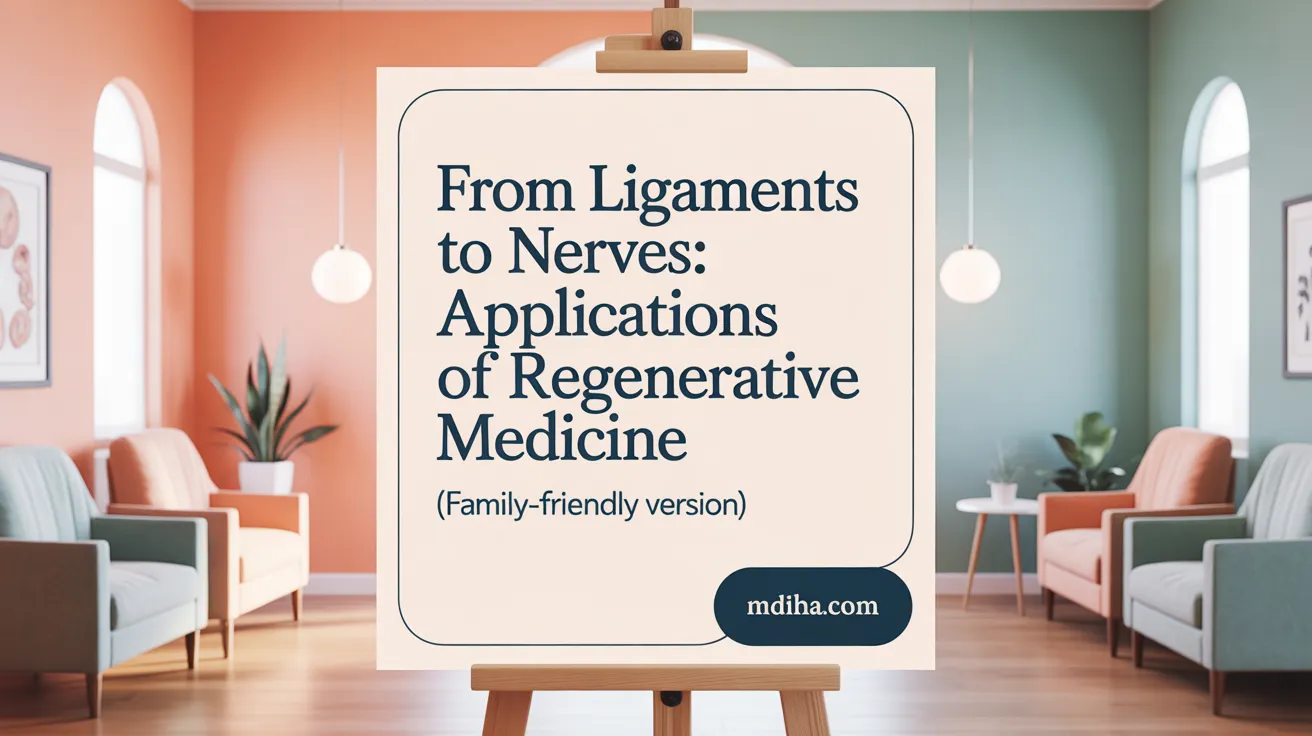Embracing a New Paradigm in Healing
Functional regeneration represents a transformative approach in medicine that transcends traditional symptom management to restore the body's natural healing capabilities at the cellular level. This article explores the philosophy, mechanisms, therapies, and clinical applications of regenerative medicine, highlighting how it promotes deep recovery, improved function, and long-term health outcomes for various conditions including orthopedic injuries and age-related diseases.
The Philosophy Behind Functional and Regenerative Medicine

What is the philosophy behind functional and regenerative medicine?
The core idea of both functional and regenerative medicine is to treat the body as an interconnected system, focusing on resolving the underlying causes of health issues rather than just alleviating symptoms. Functional medicine looks at the complex interactions between genetics, environment, and lifestyle, aiming to optimize overall wellness and prevent disease through personalized, holistic approaches.
Regenerative medicine, on the other hand, emphasizes repairing, replacing, or regenerating damaged tissues and organs. It uses innovative techniques like stem cell therapy and tissue engineering to stimulate the body’s natural ability to heal itself, promoting long-term recovery and improved function.
Both approaches prioritize natural, minimally invasive treatments that support ongoing health rather than temporary fixes. They aim to restore the body’s innate balance, reducing dependence on medications or surgery, and improving overall quality of life. Their shared philosophy underscores the importance of aligning medical interventions with the body's own healing processes, fostering a sustainable path to health.
By focusing on restoring health at a fundamental level, these fields represent a shift towards more proactive, personalized care that harnesses scientific advances to enhance natural healing capacities.
Mechanisms and Therapies Driving Regenerative Healing

What are the main mechanisms and therapies involved in regenerative treatments?
Regenerative medicine focuses on activating the body's natural repair processes at a cellular and molecular level. The primary treatments include stem cell therapy, platelet-rich plasma (PRP), exosome therapy, growth factors, and tissue engineering.
Stem cell therapy is a foundational approach. It involves harvesting cells capable of transforming into various tissue types — such as cartilage, muscle, or bone — to replace or repair damaged tissues. These cells can be sourced from the patient’s own body, like bone marrow or fat tissue, or from donor tissues like amniotic membranes, which offer high concentrations of potent stem cells.
Platelet-rich plasma (PRP) treatment concentrates platelets from a patient’s blood, rich in growth factors that stimulate cell proliferation and tissue repair. These growth factors support healing of tendons, ligaments, and joints.
Exosome therapy and cytokine treatments focus on delivering signaling molecules like proteins and RNA that mediate cellular communication and promote regeneration. Exosomes, tiny vesicles released by cells, carry these molecules and can help stimulate tissue growth and repair.
Tissue engineering and scaffold fabrication involve creating supportive structures mimicking natural tissues. Techniques such as 3D bioprinting or the use of decellularized biological matrices provide frameworks for new tissue growth and integration.
These therapies work synergistically. For example, scaffolds provide structure, growth factors stimulate cells, and stem cells differentiate into needed tissues. Carefully addressing vascularization and innervation ensures new tissues gain blood supply and nerve function, vital for restoring full functionality.
The success of regenerative treatments relies on modulating immune responses to prevent rejection, ensuring proper integration of new tissues, and activating pathways that regenerate tissue structure and function effectively.
How these therapies regenerate tissue structure and function
By replacing damaged cells with new, healthy ones, and providing the biological signals necessary for tissue growth, these therapies aim to rebuild the injured area precisely. Regeneration restores normal tissue architecture, including cartilage, muscle, or nerve tissues, leading to improved function.
Moreover, these approaches can stimulate the growth of blood vessels and nerves within the regenerating tissue, ensuring full integration and performance.
Overall, regenerative medicine employs an intricate mix of biological techniques to recreate complex tissue environments and restore health, moving beyond symptom management toward genuine repair and long-term healing.
Specific Regenerative Therapies and Their Clinical Applications
 Regenerative medicine offers a collection of innovative treatments designed to repair, replace, and regenerate damaged tissues. Among the most common therapies are stem cell therapy and Platelet-Rich Plasma (PRP) therapy.
Regenerative medicine offers a collection of innovative treatments designed to repair, replace, and regenerate damaged tissues. Among the most common therapies are stem cell therapy and Platelet-Rich Plasma (PRP) therapy.
Stem cell treatments primarily use cells harvested from sources such as bone marrow, fat tissue, or amniotic membranes. These stem cells can mature into nearly any tissue type, including cartilage, muscle, or bone, making them highly versatile. For example, in orthopedic injuries like osteoarthritis or meniscus tears, stem cells are injected directly into the affected joint to stimulate healing and tissue regeneration.
PRP therapy involves drawing blood from the patient, processing it to concentrate platelets, and then injecting this Platelet-Rich Plasma into injury sites. The high concentration of platelets releases growth factors that promote tissue repair and reduce inflammation. It’s often used for tendinitis, ligament sprains, and degenerative joint conditions.
Other treatments include prolotherapy, which injects a dextrose-based solution to stimulate the body’s natural healing process, especially in areas of chronic pain or joint instability. Platelet lysate, a product derived from platelets, supports nerve regeneration after nerve injuries by delivering essential growth factors.
These procedures are minimally invasive, often performed in-office with little downtime. They can be customized based on individual patient needs. Conditions treated with these therapies span from joint degeneration, ligament sprains, and tendinitis to nerve pain, aging-related tissue deterioration, and degenerative diseases.
Regenerative therapies aim to activate the body’s innate healing mechanisms by delivering biological materials such as stem cells, growth factors, and extracellular vesicles. This approach not only shortens recovery times but also reduces reliance on medications and surgeries. Overall, these treatments represent a significant advancement in addressing both symptoms and underlying causes of various conditions.
| Therapy Type | Uses | Source of Cells/Materials | Typical Conditions Treated |
|---|---|---|---|
| Stem Cell Therapy | Tissue regeneration, joint repair | Bone marrow, fat, amniotic membrane | Osteoarthritis, ligament injuries, tendonitis |
| PRP Therapy | Accelerate healing, reduce inflammation | Patient’s blood platelets | Tendinitis, ligament injuries, degenerative joint disease |
| Prolotherapy | Stimulate natural tissue repair | Dextrose solution | Chronic pain, joint instability |
| Platelet Lysate | Support nerve and tissue regeneration | Platelets (blood component) | Nerve injuries, neurological conditions |
By leveraging the body’s natural healing capacity, regenerative therapies provide personalized, effective, and less invasive options for patients seeking to restore function and alleviate pain.
Benefits and Outcomes of Functional Regeneration for Patients

What benefits and potential outcomes can patients expect from regenerative health approaches?
Patients undergoing regenerative medicine treatments can anticipate several positive outcomes. Most notably, these therapies often lead to a significant reduction in pain and inflammation, which helps improve mobility and daily function.
One of the hallmark advantages is faster recovery. Treatments like platelet-rich plasma (PRP) injections or stem cell therapy stimulate the body’s natural healing processes, promoting quicker repair of damaged tissues such as cartilage, tendons, ligaments, and bones. This accelerated healing often enables individuals to resume their normal activities sooner than with conventional methods.
Another major benefit is the minimally invasive nature of these procedures. Many regenerative treatments are performed with little to no surgical incision, making them safer with fewer risks than traditional surgeries. This approach also results in minimal downtime, allowing patients to return to their routines quickly.
Regenerative medicine also offers the potential to delay or even avoid surgical interventions altogether. By restoring damaged tissues and halting degenerative processes early, patients might prevent the need for invasive surgeries down the line.
Furthermore, these therapies aim for long-term tissue restoration, addressing the root causes of chronic conditions rather than just alleviating symptoms. Over time, this can lead to improved quality of life, enhanced joint function, and sustained relief from pain.
In summary, regenerative treatments provide a safe, effective, and natural way to heal damaged tissues, reduce discomfort, and improve overall well-being, often with lasting results and a lower risk profile than traditional surgical options.
Regenerative Medicine in Orthopedics, Chronic Pain, and Aging: Advances and Future Directions
How does regenerative medicine contribute to the treatment of orthopedic injuries, chronic pain, and age-related health issues?
Regenerative medicine plays a transformative role in managing orthopedic injuries, chronic pain, and signs of aging by harnessing the body's natural repair mechanisms. It employs biological therapies such as stem cell treatments, platelet-rich plasma (PRP), and other orthobiologic substances to stimulate tissue healing and regeneration.
For orthopedic conditions like osteoarthritis, tendinitis, ligament sprains, and cartilage injuries, regenerative methods promote the growth of new, healthy tissues. Techniques like prolotherapy—an injection of a dextrose solution—trigger the body’s own healing response. Additionally, advanced therapies such as extracorporeal shockwave therapy and pulsed electromagnetic fields accelerate recovery and reduce inflammation.
In managing chronic pain, regenerative approaches target the root causes rather than just symptoms. For example, PRP injections deliver concentrated growth factors directly into damaged tendons and joints, boosting repair processes. Stem cell therapies, often using cells derived from bone marrow or adipose tissue, can regenerate damaged cartilage and soft tissues, resulting in decreased reliance on pain medications.
Regarding aging, these therapies support tissue remodeling and collagen production, aiding in slowing or reversing degenerative changes typical in musculoskeletal tissues. Cellular regeneration stimulated by these treatments helps preserve joint function, improve mobility, and delay the progression of age-related decline.
While many of these therapies offer promising results, ongoing research aims to standardize protocols and establish strong clinical evidence. As the field advances, regenerative medicine holds the potential to reduce the need for invasive surgeries, decrease dependency on medications, and improve long-term health outcomes for aging populations.
Functional Regeneration: The Future of Healing
Functional regeneration embodies a shift from symptom-focused care to restoring the body's inherent ability to heal and regenerate. By deploying cutting-edge therapies like stem cell treatment and PRP within a holistic framework, regenerative medicine offers promising solutions for chronic pain, orthopedic injuries, and age-associated decline. As research advances and personalized protocols evolve, functional regeneration holds the potential to transform patient outcomes by addressing root causes and achieving lasting recovery. Embracing this paradigm invites a future where medicine supports true healing beyond managing symptoms.
References
- Natural Healing & Pain Relief Solutions - Regenerative Neuropathy
- Healing Beyond Pain: Conditions & Injuries Treated at CHARM
- The Benefits of Regenerative Medicine - Pain & Wellness Institute
- Healing Your Body on a Cellular Level with Regenerative Medicine
- Regenerative Medicine | VeriSpine Joint Centers
- Regenerative Medicine for Orthopedic Injury Recovery
- 10 Ways Regenerative Medicine Can Enhance Your Longevity and ...
- Regenerative Medicine | Sievers Sports Medicine in Portales , NM
- Regenerative Medicine in Indianapolis Pain & Wellness Center
- Regenerative Medicine: Transforming Wellness and Quality of Life
